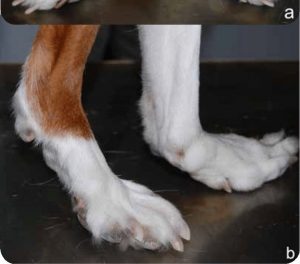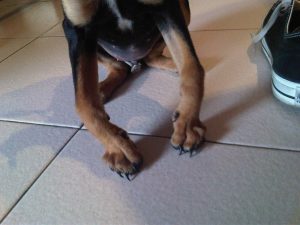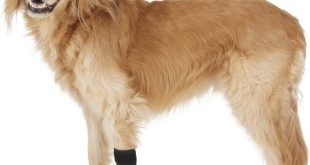So, you have a puppy at home who’s less than 4 months old, and one day, you notice that its wrist looks bulged out…or you notice that he walks with its entire paw touching the ground. It’s an obvious deformity. Your pup may or may not be experiencing pain, however you can tell that he looks pretty uncomfortable just from the way he walks and sometimes cries in pain.
Its legs may also look odd with obvious swelling and then you begin to look for a possible cause. If you have observed all of these symptoms in your dog, chances are your dog possibly has Carpal Laxity syndrome, more commonly known as Knuckling over in dogs. It does go by other names such as Carpal Flexural Deformity in Dogs, Carpal Hyperextension, and Carpal Hyperflexion.
Wait what! Don’t freak out just yet. This isn’t any sort of pathogenic disease that can kill your dog, and it’s something you’re most likely to get him help with.
I know you have several questions, so I’ll tell you everything you need to know about it in a moment.
Table of Contents
- What is Carpal Laxity Syndrome?
- How do I know if my dog has Carpal Laxity syndrome?
- Diagnosis of Carpal hyperextension/hyperflexion in Dogs
- How does Carpal Laxity Syndrome affect my dog?
- Why should I consider this a problem since it doesn’t kill?
- How can I treat this problem?
- Is there a way to manage this condition at home?
- Risk Factors
What is Carpal Laxity Syndrome?

Carpal Laxity Syndrome also called knuckling over in dogs/puppies is a general term used to describe hyperextension or hyperflexion in dogs. This condition is often noticed on your dog’s legs when it’s below 4 months old (but sometimes, it can be seen in 7-month-old pups).
In rescue puppies, this condition can typically be seen where a puppy has come into care suffering from malnutrition.
When malnourished puppies suddenly start getting quality nutrition, this can lead to rapid growth which can trigger the condition. So, it is recommended that such puppies are not over-fed to put on weight.
Sometimes this condition is simply unavoidable in malnourished puppies. Interestingly, some breeds such as Shar Peis and Dobermann’s appear to be predisposed to the condition. Its interesting to note that male puppies especially seem to be more affected due to their very rapid growth.
Your pup may be unilaterally or bilaterally affected. This means it can affect just one of its front legs or both of them. Additionally, while all dog breeds can be affected, larger dogs tend to be more prone to having this syndrome compared to smaller dog breeds.
As was stated earlier your pup’s carpal laxity syndrome may be a result of hyperextension or hyperflexion. Let’s discuss what they are.
Carpal Hyperextension

Carpal hyperextension is noticed when you notice that your pup walks with the palm or plant of his paws touching the ground (known respectively as a ‘palmigrade’ or ‘plantigrade’ stance).
With regards to the fact that dogs walk on the tip of their toes, unlike humans.
In puppies, the hyperextension is mainly due to the looseness of the carpal flexor tendons associated with poor muscle tone.
Affected puppies walk with the excessive extension of the carpus (with a gait more like a bear than a dog).
Both wrists tend to be affected in puppies with this condition and in some extreme cases, the hock joints (ankles) in the hind limbs can also be affected.
Puppies that have ligament laxity and subsequent hyperextension of the carpus as a result of prolonged immobilization in a bandage are only affected on the bandaged leg.
Also, hyperextension can result from a traumatic event that ruptures the palmar ligaments in a dog’s front foot. This traumatic event may be falling from a significant height.
In this case, some dogs will have an obvious postural abnormality with an inappropriate deviation of the affected joint.
Carpal hyperextension can also occur as a slow phenomenon due to degeneration of the ligaments, where the dog becomes progressively palmigrade (this tends to happen to older dogs and is especially common in Collie breeds).
There is a tendency for one or both carpi to gradually sink until they completely collapse.
What is important is for your vet to differentiate these scenarios from a different condition known as hyperflexion.
Carpal Hyperflexion
Carpal Hyperflexion is originally noticed in the growth plate of your pup’s front legs, either in the wrist or carpal area, occurring when the part of your dog’s body that bears weight is not able to support its entire body as a result of the muscle, tendon, and ligaments being poorly developed.
If your dog is experiencing carpal flexural deformity, it will typically occur when it’s under four months old.
And you’ll notice a bulge forward or over flex on its wrist.
While the cause of the condition is not known, multiple theories have not been confirmed.
Some believe that the condition is a result of a temporary imbalance in the rate of growth between the bones and tendons of the front limbs.
Others propose causes to be genetically influenced, caused by malnutrition, and an excess of vitamins and minerals. Although there isn’t enough evidence to support these claims.
Dogs who suffer carpal hyperextension/hyperflexion do not present signs of disease or other pathology.
How do I know if my dog has Carpal Laxity syndrome?
This condition is easily visible especially if you’re a dog parent who is conscious of his/her pup.
It is a deformity that isn’t hidden and it presents itself visibly, you’ll notice that your pooch has an elongated carpus and it’s paw lays flat on the ground when it walks.
The first red flag is often the twisting of toes, this is the ligament laxity beginning, and whilst some puppies will not advance past this stage, this is an indication that something isn’t right and that you need to have a look at your pup’s diet and the environment if your pup hasn’t been malnourished.
Overweight puppies are at higher risk of developing this condition, it is very important to grow your puppy lean especially if it belongs to a large-giant breed.
But to be sure your pup’s only problem is Carpal Laxity Syndrome, it’s best to visit a veterinarian for proper diagnosis and advice on how to manage your pooch’s condition at home.
Diagnosis of Carpal hyperextension/hyperflexion in Dogs
On your pup’s appointment, you will be asked about when you first noticed the condition, as well as any other symptoms you have observed.
Your veterinarian will conduct a physical examination of your dog (to include watching him walk) where he will look for excessive hyperextension/hyperflexion at the carpus.
Depending on what is seen, your veterinarian may recommend conducting x-rays, where your dog will be sedated, and/or clinical pathologic testing.
Carpal hyperextension/hyperflexion is typically diagnosed following a multimodal evaluation process.
Firstly your dog should be examined by an orthopedic clinician to ascertain the nature of the problem.
Following this, your dog will most likely be admitted to the hospital to allow radiographs of the affected joints under sedation or general anesthesia.
Here, a series of specific radiographs called ‘stressed views’ may be performed.
This entails taking a radiograph of your dog’s carpus in the position that truly reflects the extent of the hyperextension/hyperflexion.
This will help the orthopedic clinician assess which ligamentous structures are damaged and facilitate the overall decision-making process as to what treatment is best for your dog.
Also, your pup may require additional diagnostic imaging such as CT or MRI which will be performed by advanced diagnostic imaging.
Following clinical examination and diagnostic imaging, the orthopedic clinician will be able to advise on the most appropriate course of treatment for your dog, be it conservative (non-surgical) management or surgical management.
Also, a physical examination can give a good idea of the nature of the problem.
In this case, special stressed radiographic tests may be done to assess which ligamentous structures are damaged.
In pups where broken bones are suspected but are not seen on the plain radiographs, a CT scan is often recommended. And occasionally, MRI can provide useful additional information.
How does Carpal Laxity Syndrome affect my dog?
For carpal hyperextension, your dog may present symptoms like;
- Pain and swelling on the forelimb.
- Abnormal, hyperextending stance and gait.
- Crying or pain vocalization.
- Increased distal limb extension.
- Joint instability
While if your dog has hyperflexion, it may not be in pain.
It may show lameness and difficulty walking if the deformity is significant.
This means without treatment your dog can have;
- Difficulty walking.
- Over flexion.
Why should I consider this a problem since it doesn’t kill?
I doubt you or anyone else will be happy when your pup grows up and is unable to play “catch”.
Also, let’s say your pup is having pain due to hyperextension/hyperflexion…will you be able to watch your best friend suffer when you can actually do something about it?
Of course not!
Same way nobody enjoys being handicapped, your dog would be happy to live a full life.
This is exactly why you should do all it takes to help your pup feel better.
Remember, a happy pup makes a happier family.
So, next are treatment options that may help your pup.
How can I treat this problem?
Treatment depends on whether your pup has hyperextension or hyperflexion
For hyperextension, the treatment depends on the cause of the problem.
When the reason for the hyperextension is a traumatic rupture or a degeneration of the palmar ligaments, it is important to know that the palmar ligaments do not heal well following injury and if a splint or a cast is applied the problem may persist.
In such a case, the only solution is surgery, where the wrist is fused in a functional position (10 degrees of extension) in a procedure known as ‘arthrodesis’. This is normally achieved in surgery by using one or two plates and screws.
It’s however important to note that, although this procedure has associated complications, it has a good prognosis.
In other cases where the cause is uncertain, it is often difficult to know what the ideal treatment for the condition should be.
A study published in the “Veterinary and Comparative Orthopaedics and Traumatology” journal showed that a balanced diet and gentle exercise may be enough to reverse the problem.
For example, your vet may suggest switching to an adult formula of dog food to slow the rapid growth that worsens the condition.
If the condition is severe, your vet may also recommend a soft wrap like a bandage.
But know this, the use of hard splints may restrict the use of the muscle and may make the condition worse.
After this, if the problem persists, a surgical fusion of the wrist should be considered once the growth potential of the puppy is minimal.
In a case of hyperflexion, the aim of the treatment is often to improve muscle tone with a regime of short and frequent walks, normally on a hard surface with good grip.
If you do this for your pup, you should be able to notice an improvement over 4-8 weeks.
According to experiences from dog parents, this method is said to work in approximately 50% of cases.
In cases where your pooch struggles to walk, penning/crating may seem appropriate, but it is generally recommended that your dog still moves about on appropriate surfaces where it can have a good grip.
Is there a way to manage this condition at home?
Although this condition is generally self-limiting, affected puppies should only ever be on surfaces they can grip, this means they should not be slippery surfaces such as floorboards, etc.
Taking an affected puppy on a walk is not appropriate nor is physical play…the only exercises you should subject your pup to are those recommended by your vet.
Your pooch should be kept on surfaces such as carpet, rubber mats, and grass they can easily grip.
You should ensure you are not overfeeding your dog because growing your dog in a lean state is very crucial to resolving carpal laxity syndrome.
Choose a high-quality diet and avoid low-quality supermarket dry & tinned foods…
While it’s important to avoid giving your dog calcium supplements, you may also consult your vet for some supplement recommendations that will be beneficial to your pooch.
In all, take a common-sense approach and follow the advice of your vet.
Risk Factors associated with Carpal Laxity Syndrome
Certain puppies are at a higher risk for carpal laxity syndrome these are the large and medium breed puppies. The small breeds are usually unaffected when it comes to knuckling over.
Certain breeds, including Shar Peis, Doberman pinschers, German shepherds, and Great Danes, suffer from carpal laxity more frequently – this is most likely because they are large breeds…although, it may also be genetically related.
There also seems to be a higher incidence among male puppies than female puppies, according to an article published in the “Veterinary and Comparative Orthopedics and Traumatology” journal.
Whatever the cause, the recovery rate is high and most puppies with this condition will go on to lead completely normal lives.
So, you see, it’s something you can manage after all.
Good luck with giving your pup the best care!
 Total Pooch Dog Supplements, Tear Stain Removers, De-wormers, Tylosin for Dogs and other great products.
Total Pooch Dog Supplements, Tear Stain Removers, De-wormers, Tylosin for Dogs and other great products.




